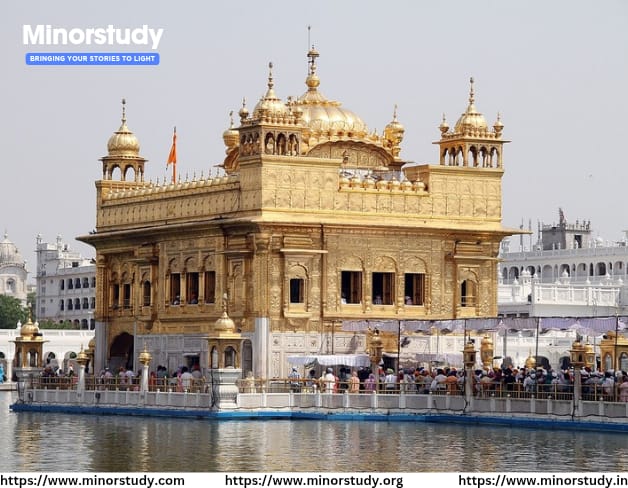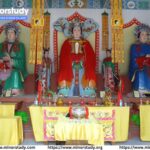🔱 7 Powerful Reasons Why Sri Harmandir Sahib Inspires Millions Globally 🌟
🛕 Introduction: A Temple That Glows with Devotion and Equality
Sri Harmandir Sahib, also known as The Golden Temple, stands as the spiritual and cultural epicenter of Sikhism. Located in Amritsar, Punjab, India, it is not just a place of worship—it is a living symbol of devotion, sacrifice, equality, and hope. Wrapped in pure gold and surrounded by the sacred Amrit Sarovar (pool of nectar), this temple welcomes everyone—regardless of caste, creed, or religion—with open arms.
- 📜 History of Sri Harmandir Sahib: From Vision to Reality
- 🪔 7 Lesser-Known Facts About Harmandir Sahib
- 🕰️ Timeline of Events: A Journey Through Time
- 💫 Spiritual and Societal Significance
- 🎉 Observance: How It’s Celebrated
- 🙏 Wishing from the Heart: A Sample Human-Centric Message
- 💡 Why It’s Important in Our Life and Daily Society
- ❓ Frequently Asked Questions (FAQs)
- 🏛️ What does “Harmandir Sahib” mean?
- 🌍 Can non-Sikhs visit the Golden Temple?
- 👟 Is there a dress code?
- 🍛 Can I volunteer at Langar?
- 📍 Where is it located?
- 🕯️ Is there any fee to visit?
- 🧭 Important Points to Remember
- 🔚 Conclusion: Why Harmandir Sahib Matters Today
📜 History of Sri Harmandir Sahib: From Vision to Reality
The story of Sri Harmandir Sahib is one of spiritual vision and historical resilience.
Conceptualized by Guru Amar Das Ji (3rd Sikh Guru)
He envisioned a central place for Sikhs to congregate.Founded by Guru Ram Das Ji (4th Sikh Guru) in 1577 CE
He began the excavation of the Amrit Sarovar.Constructed by Guru Arjan Dev Ji (5th Sikh Guru)
In 1604, Guru Arjan Dev Ji completed the temple and installed the Adi Granth Sahib (holy scripture) inside.Attacked & Rebuilt
The temple faced destruction multiple times by invaders like Ahmad Shah Abdali but was rebuilt each time by the resilient Sikh community.Golden Transformation by Maharaja Ranjit Singh (1800s)
He gilded the upper floors with gold, hence the popular name: The Golden Temple.
🪔 7 Lesser-Known Facts About Harmandir Sahib
🔄 The Entrance Has Four Doors: Signifying openness to all castes and religions.
💛 Real Gold on the Dome: Over 750 kg of pure gold was used.
🔇 No VIP Culture: Everyone sits and eats together at Langar, including celebrities and politicians.
🌊 Amrit Sarovar: The holy water tank is believed to have healing powers.
📖 Continuous Recitation: Guru Granth Sahib is read aloud 24/7.
🍛 World’s Largest Free Kitchen: Serves over 100,000 meals daily—without asking for money.
🧼 Cleaned by Volunteers: Devotees clean the floors, polish the brass, and even wash the dishes.
🕰️ Timeline of Events: A Journey Through Time
| Year | Event |
|---|---|
| 1577 | Guru Ram Das Ji founded Amritsar city and started Sarovar excavation. |
| 1581–1604 | Guru Arjan Dev Ji constructed the Harmandir Sahib. |
| 1604 | Guru Granth Sahib was installed in the sanctum. |
| 1762 | Destroyed by Afghan invaders; rebuilt by Sikhs. |
| 1802 | Maharaja Ranjit Singh began the gold overlay work. |
| 1984 | Operation Blue Star—tragic military operation took place. |
| Today | Welcomes millions of visitors yearly with devotion and peace. |
💫 Spiritual and Societal Significance
Sri Harmandir Sahib isn’t just a sacred place—it radiates universal human values.
💓 Spiritual Unity
Anyone can enter and worship—no discrimination.
Emphasis on Naam Japna (chanting the divine name), Kirat Karni (honest living), and Vand Chakna (sharing).
🤝 Equality in Action
Langar (community kitchen): All sit in a row regardless of status—this is true democracy in practice.
No priests with special rights—the scripture and the people hold equal place.
🕊️ Symbol of Resilience
Rebuilt multiple times—symbolizing spiritual strength and unity.
Reminds us of peaceful resistance and the power of the community.
🎉 Observance: How It’s Celebrated
Though not associated with a single festival, Harmandir Sahib lights up in celebrations such as:
Guru Nanak Gurpurab
Baisakhi (Khalsa Foundation Day)
Diwali (Bandi Chhor Divas)
Martyrdom Days of Sikh Gurus
Sikh New Year (Hola Mohalla)
During these events, fireworks, light decorations, devotional music, and community feasts elevate the already divine atmosphere.
🙏 Wishing from the Heart: A Sample Human-Centric Message
“May Sri Harmandir Sahib bless you with peace, humility, and a life of purpose. Let its golden reflection remind us daily to shine from within—offering love, equality, and service to all.”
💡 Why It’s Important in Our Life and Daily Society
🌍 Global Harmony
Harmandir Sahib is a living model of interfaith respect. It doesn’t promote religion; it promotes compassion.
🧠 Mental Peace
The serene chanting and tranquil waters offer mental and emotional peace. Many find personal transformation after visiting.
🍽️ Eradicating Hunger
The Langar system is an anti-hunger model that can be adopted globally—sustainable, inclusive, and deeply humane.
👣 Volunteerism in Action
The entire temple runs on seva (selfless service)—cleaning, cooking, managing queues, etc. This is civic responsibility in its purest form.
❓ Frequently Asked Questions (FAQs)
🏛️ What does “Harmandir Sahib” mean?
Harmandir Sahib means “The Temple of God.”
🌍 Can non-Sikhs visit the Golden Temple?
Yes, absolutely! People of all religions, countries, and backgrounds are welcome.
👟 Is there a dress code?
Visitors must cover their head, remove shoes, and dress modestly.
🍛 Can I volunteer at Langar?
Yes, you can participate in any seva, including cooking, cleaning, and serving.
📍 Where is it located?
In the city of Amritsar, Punjab, India.
🕯️ Is there any fee to visit?
No entry fee is charged. Everything, including food, is free of cost.
🧭 Important Points to Remember
Always cover your head inside the premises.
Alcohol, tobacco, and meat are strictly prohibited.
Respect the sanctity—avoid loud conversations or photography inside the main sanctum.
Cleanliness and humility are core values during your visit.
Carry your devotion, not your ego.
🔚 Conclusion: Why Harmandir Sahib Matters Today
In a world clouded by division, Sri Harmandir Sahib stands as a radiant example of unity. Its golden reflection in the Amrit Sarovar is not just a visual spectacle—it’s a spiritual call for humans to awaken their compassion, equality, and faith.
It teaches us to live simply, serve selflessly, and treat everyone with respect. Its influence goes beyond religion—it is a beacon of light in our daily lives, modern society, and global community.








